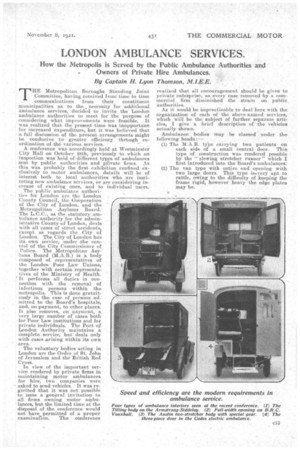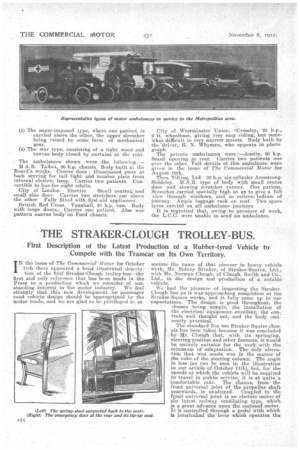LONDON AMBULANCE SERVICES.
Page 9

Page 10

If you've noticed an error in this article please click here to report it so we can fix it.
How the Metropolis is Served by the Public Ambulance Authorities and Owners of Private Hire Ambulances.
By Captain H. Lyon Thomson, M.I.E.E.
THE Metropolitan Boroughs Standing Joint Committee, having received from time to time communications from their constituent municipalities as to the . necessity for additional ambulance services, decided to invite the London ambulance authorities to meet for the purpose of considering what improvements were feasible. It was realized that the present time was inopportune for increased expenditure, but it was believed that a full discussion of the present arrangements might be conducive to greater efficiency thrbugh co
ordination of the various services. _
A conference was accordingly held at Westminster City Hall on October 28th, previously to which an inspection was held of-different types of ambulances
• sent by public authorities and private firms. As this was probably the first exhibition confined exclusively to motor ambulances, details will be of interest both to local authorities who are institut•ing new ambulance services, or are considering increase of existing ones, and to individual users. The public ambulance authori-• ties for London are the London County Council, the Corporation of the City of London, and the Metropolitan Asylums Board. The L.C.C., as the statutory ambulance authority for the administrative County of London, deals with all cases of street accidents, except as regards the City of London. The City of London has its own service under 4.-be control of the City Commissioner of Police. The Metropolitan Asylums Board (M.A.B.) is a body composed of representatives of the London Poor Law Unions, together with certain representatives of the Ministry of Health. ' It performs all duties in con• nection with the removal of infectious persons within the metropolis. This is done gratuitously in the ease of persons admitted to the Board's hospitals, and, on payment, to other places. It also removes, on payment, a Very large number of eases both for Poor Law institutions and for private individuals. The Port of London Authority maintains a complete service, but deals only with cases arising within its own area.
The voluntary bodies acting in London are the Order of St. John of Jerusalem and the British Red Cross.
In view of the important service rendered by private firms in maintaining motor ambulances for hire, two companies were asked to send vehicles. It was regretted that it was not possible to issue a general invitation to all firms owning motor ambulances, but the limited time at the disposal of the conference would not have permitted of a proper examinafion. The conference realized that all encouragement should be given to private enterprise, as every case removed by a commercial. firm diminished the strain on public authorities.
As it would be impracticable to deal here with the organization of each of the above-named services, which will be the subject of further separate articles, I give a brief description of ' the vehicles actually shown.
Ambulance bodies may be classed under the following heads:—
(1) The M.A.B. type carrying two patients an each side of a small central door. This type of construction was rendered possible by the " slewing stretcher rmaner" which I first introduced into the Board's ambulances: (2) The van type with entire, end opening with • two large doors. This type is.very apt to rattle, owing to the difficulty of keeping the frame rigid, however heavy 'the edge plates may be. (3) The super-imposed type, where one patient is carried above the other, the upper stretcher being raised by some form of mechanical gear.
(4) The war type, consisting of a light wood and canvas body closed by curtains at the rear.
The ambulances shown were the following :— M.A.B. Talbot, 20 h.p. chassis. Body built at the Beard's wo;ks. Centre door ; illuminated pane at back serving for tail light and number plate from internal electric lamp. Carries two patients. Convertible to bus for eight adults.
City of London. Electric. Small central, and small side door. Carries two stretchers one above the other Fully fitted with first-aid appliances.
British Red Cross. Vauxhall, 20 h.p. van. Body with large doors.. Carries one patient. Also war pattern canvas body on Ford chassis.
City of Westminster Union. Crossley, 25 h.p., 9 ft. wheelbase, giving very easy riding, but somewhat difficult in very narrow streets. Body built by the -driver, R. N. Wbyman, who appears in photo graph. The private ambulances were :—Austin, 20 h.p. Small opening in rear. Carries two patients one ever the other. Full details of this ambulance were given in the issue of The Commercial Motor for August 16th.
Thos. Tilling, Ltd. 30 h.p. six-cylinder ArmstrongSiddeley. M.A.B. type of body with small centre door and slewing stretcher runner. One patient. Stretcher carried specially high so as to give a full view through windows, and so relieve i tedium of journey. Ample luggage rack on roof. Two spare tyres carried on all ambulance journeys.
It is regretted that, owing to pressure of work, the L.C.C. were unable to send an ambulance.
































